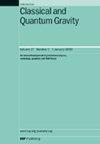Rescaled Einstein–Gauss–Bonnet gravity inflation
IF 3.6
3区 物理与天体物理
Q2 ASTRONOMY & ASTROPHYSICS
引用次数: 0
Abstract
We study the inflationary phenomenology of a rescaled Einstein–Gauss–Bonnet (EGB) gravity. In this framework, the gravitational constant of the Einstein–Hilbert term is rescaled due to effective terms active in the high curvature era. Basically, the total theory is an theory with the Gauss–Bonnet part contributing only a non-minimal coupling to the scalar field, so it is a theory with string theory origins and with a non-trivial F(R) gravity part. The F(R) gravity part in the high curvature regime contributes only a rescaled Einstein–Hilbert term and thus the resulting theory is effectively a rescaled version of a standard EGB theory. We develop the formalism of rescaled EGB gravity, taking in account the GW170817 constraints on the gravitational wave speed. We show explicitly how the rescaled theory affects directly the primordial scalar and tensor perturbations, and how the slow-roll and observational indices of inflation are affected by the rescaling of the theory. We perform a thorough phenomenological analysis of several models of interest and we show that is it possible to obtain viable inflationary theories compatible with the latest Planck data. Also among the studied models there are cases that yield a relatively large blue tilted tensor spectral index and we demonstrate that these models can lead to detectable primordial gravitational waves in the future gravitational wave experiments. Some of the scenarios examined, for specific values of the reheating temperature may be detectable by SKA, LISA, BBO, DECIGO and the Einstein Telescope.重标Einstein-Gauss-Bonnet重力暴胀
我们研究了重标einstein - gas - bonnet重力的暴胀现象学。在这个框架中,爱因斯坦-希尔伯特项的引力常数由于在高曲率时代活跃的有效项而被重新标称。基本上,总的理论是一个高斯-邦纳部分只对标量场产生非极小耦合的理论,所以它是一个具有弦理论起源和非平凡F(R)引力部分的理论。高曲率体系中的F(R)引力部分只贡献了一个重标的爱因斯坦-希尔伯特项,因此得到的理论实际上是一个标准EGB理论的重标版本。考虑到GW170817对引力波速度的限制,我们发展了重标化的EGB重力的形式。我们明确地展示了重新标度的理论如何直接影响原始标量和张量摄动,以及膨胀的慢滚和观测指数如何受到理论的重新标度的影响。我们对几个感兴趣的模型进行了彻底的现象学分析,并表明有可能获得与最新普朗克数据相容的可行的暴胀理论。此外,在所研究的模型中,也存在产生相对较大的蓝色倾斜张量谱指数的情况,我们证明这些模型可以在未来的引力波实验中导致可探测的原始引力波。对于重新加热温度的特定值,一些被检查的场景可能被SKA、LISA、BBO、DECIGO和爱因斯坦望远镜探测到。
本文章由计算机程序翻译,如有差异,请以英文原文为准。
求助全文
约1分钟内获得全文
求助全文
来源期刊

Classical and Quantum Gravity
物理-天文与天体物理
CiteScore
7.00
自引率
8.60%
发文量
301
审稿时长
2-4 weeks
期刊介绍:
Classical and Quantum Gravity is an established journal for physicists, mathematicians and cosmologists in the fields of gravitation and the theory of spacetime. The journal is now the acknowledged world leader in classical relativity and all areas of quantum gravity.
 求助内容:
求助内容: 应助结果提醒方式:
应助结果提醒方式:


